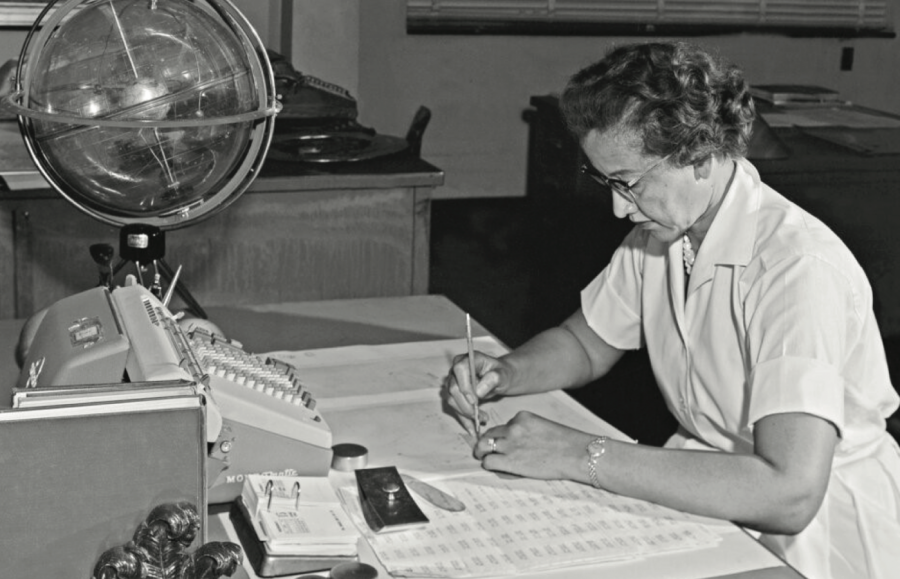Kathrine Johnson’s legacy: inspiring young women to pursue STEM careers
Students reflect on Johnson’s vision
On Feb. 24 Katherine Johnson, known for her pioneering work in the male-dominated industry of NASA, as well as Taraji P. Henson’s portrayal of her in the 2017 break-out film “Hidden Figures,” passed away at the age of 101.
With International Women’s Day recently behind us, it’s time to reflect how far women have come in the field that Johnson helped pioneer: STEM.
For sophomore Parker Peterson, who actively participates in SWEETS, a female-oriented STEM program that meets every Monday, Johnson was especially inspiring.
“If Johnson was standing right in front of me, I’d say thank you for inspiring young girls and proving to them that they can make a difference one day in STEM or any other career [that] they choose to pursue,” Peterson said. “I remember before I saw her movie, I was really naïve to the fact that women aren’t given nearly enough opportunities in STEM than men are.”
After graduating with highest honors at the historically black campus of West Virginia State College in 1937, Johnson started her career as a NASA ‘calculator’ in 1952. 10 years later, she was called upon to do her most famous work: the “Friendship” mission of astronaut John Glenn.
According to NASA’s official biography of Johnson, as a part of the preflight checklist, Glenn asked engineers to “get the girl”— Johnson—to run the same numbers through the same equations that had been programmed into a computer, but by hand, on her desktop mechanical calculating machine.
“If she says they’re good, then I’m ready to go,” Glenn said. She then went on to perform calculations for the Apollo 11 Moon Landing and several other missions. At the age of 97, she was awarded the Presidential Medal of Freedom, and in 2016, NASA opened the Katherine G. Johnson Computational Building.
According to the Pew Research Center, women have generally come to comprise a larger percentage of STEM fields from 1990-2016. However,womenremainaminority in math, life science, physical science, computer, and engineering fields. The percentage of women working in computer science has decreased from 32% to 25% in that time, and women in only make up 14% of engineers (up from 12% in 1990).
Maryanne Xu is a sophomore and one of the most devoted members of Binary Heart. The goal of the club is to rebuild, refurbish, and reprogram older computer models and send them off to charities. Her take on the NSF statistic is pretty grounded in the realm of logic, and she breaks it down to a matter of culture and predispositions.
“It mainly depends on the field or the context to me,” Xu said. “For example, not a lot of women go into something like computer science, but since a lot of women are associated with nursing and biology, and that’s why women can easily become doctors or biologists as opposed to programmers or computer scientists.”
It appears that Xu isn’t too far off about the last part of that, because New Trier’s Computer Science
Club has a bit of a gender gap, but that doesn’t mean the women there aren’t talented programmers. One of these female tech wizards is Isabella Allada, a senior and one of the heads of Binary Heart club. She inherits her penchant for computer tinkering and overall love of STEM from her diligent neurobiologist parents.
“There’s still some rampant sexism within the STEM community,” Allada said. “I feel like it’s better since some people aren’t outwardly sexist, but I feel like there’s an underlying pressure that plenty of women face that is telling them not to pursue high-paying careers.”
Despite the gender gap in the Computer Science club, the group recently got itself a new female sponsor: Niha Janagama. Janagama, who is an enterprise application manager, said a hero of hers in the STEM field is Marie Curie.
“Her work and discoveries were revolutionary, she never gave up, and just like a lot of women in these fields, she had a lot to juggle.”
Whatever your thoughts on women in STEM, there’s no question that the future female technicians, scientists, and mathematicians of New Trier aren’t letting anything get in their way.
Many embody a quote from Marie Curie herself, “Be less curious about people, and more curious about ideas.”







































